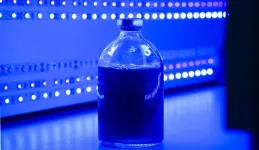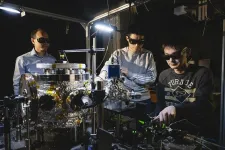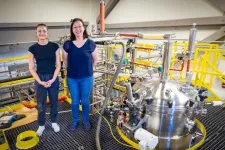(Press-News.org) "We have discovered a muscle-brain pathway that controls the eagerness to train more when we exercise," explains Guadalupe Sabio, a researcher at the Spanish National Cancer Research Center (CNIO).
One of the proteins identified activates the area of the brain that controls movement. Obese patients have lower blood levels of this protein.
This result suggest it may be possible to develop drugs for people specially in need of the benefits that come from exercise, but are reluctant to do it.
The study is published today in 'Science Advances'.
Exercising is healthy, but not always appealing. Research led by Guadalupe Sabio from the National Cancer Research Centre (CNIO) may have found a switch that activates the desire to get moving, as it shows that during exercise the muscle activates proteins which encourage further activity. The paper is published in Science Advances.
“We have discovered how muscle itself regulates interest in exercise through a signalling pathway between muscle and brain that we didn’t know about, and which is one of those responsible – as there must be several – for the fact that, when we exercise, we experience the impulse to train even more,” explains Sabio, head of CNIO’s Interaction between Organs in Metabolic Diseases Group .
The article also shows that the proteins produced by the muscle through exercise regulate each other. Thus, they prevent the desire to exercise from eventually harming the body.
The results are based on data obtained in animal models and also in humans (volunteers who performed controlled exercise, and patients with obesity). This suggests the identified signaling pathway "plays a crucial role in regulating physical activity in both mice and humans", and "highlights the potential therapeutic significance of this pathway in treating obesity and metabolic diseases", write the authors in Science Advances.
First co-authors of the study are Leticia Herrera and Cintia Folgueira, researchers at the National Center for Cardiovascular Research (CNIC).
Three proteins that influence the desire for physical activity
The group observed that when muscles contract repeatedly and intensely, due to exercise, the pathways of two proteins of the same family are activated: p38α and p38γ. Interest in physical activity is greater or lower depending on how much each of these two proteins is activated, the study shows.
There is also a third protein involved: interleukin 15 (IL-15). The authors observed that activation of p38γ by exercise induces the production of IL-15, and that this protein has a direct effect on the part of the cerebral cortex that controls movement, the motor cortex. The increase of interleukin 15 in blood functions as a signal to the brain to enhance motor activity, which makes the animals to voluntarily become more active.
"In this study, we revealed that exercise-induced activation of muscle p38γ leads to the production of IL-15, which subsequently enhances spontaneous physical activity. Furthermore, we observed the presence of this p38γ/IL-15 axis in humans after exercise, underscoring the clinical relevance of this signaling pathway in promoting exercise behavior within the population", say the authors.
The effect of regular training
When animals were made to exercise on a regular basis, the activation of p38γ was also higher than that of p38α. This leads the research team to posit that training itself keeps the desire to exercise going.
In animals fed a high-fat diet and obese, regular exercise was beneficial: it improved metabolism and reduced the tendency towards diabetes and fat accumulation, especially in the liver.
In humans
In humans it was observed that both p38 proteins are activated in muscles that were exercised with an increasing intensity. A rise in IL-15 blood levels were also detected, with obese patients showing lower values.
This link with obesity is key, authors say, this disease being the most common metabolic disorder worldwide. Regular exercise is considered an effective strategy for both obesity prevention and treatment.
"The correlation between p38γ activation in human muscle during acute exercise and increased blood IL-15 levels highlights the potential therapeutic significance of this pathway in treating obesity and metabolic diseases", write the authors on their paper.
A biomarker for the eagerness to train
For Sabio, one of the next steps will be to confirm that IL-15 is indeed a blood marker of the desire to exercise. Once this has been proved, “you would be able to study whether different types of exercises (weights, running, CrossFit…) stimulate this axis differently, and also if it has the same effect on obese and non-obese people. That can help coaches and personal trainers design their programmes more efficiently.”
She adds that “we could even think about creating an IL-15 drug for people who are more in need of the positive effects of physical exercise, and less likely to do or maintain it. For example, people with obesity.”
Guadalupe Sabio is already planning to use this model to try to better determine the relationship between exercise, longevity and cancer and discover the mechanisms that regulate it.
END
CNIO researchers discover a 'switch' for the desire to engage in physical activity: Two proteins that get activated in the muscle during exercise
"We have discovered a muscle-brain pathway that controls the eagerness to train more when we exercise," explains Guadalupe Sabio, a researcher at the Spanish National Cancer Research Center (CNIO).
2024-08-14
ELSE PRESS RELEASES FROM THIS DATE:
A taste for carbon dioxide
2024-08-14
Nitrogenases are among the most geochemically important enzymes on Earth, providing all forms of life with bioavailable nitrogen in the form of ammonia (NH3). Some nitrogenases can also directly convert CO2 into hydrocarbon chains, making them an exciting target for the development of biotechnological processes. A team of researchers in Marburg, Germany, led by Max Planck scientist Johannes Rebelein, has now provided a comprehensive insight into the substrate specificity and preferences of nitrogenase. Their results challenge the current understanding of nitrogenases and highlight their potential for sustainable bioproduction.
Nitrogen is one of the main building blocks ...
US companies' global market reach linked to cloud computing use
2024-08-14
UNIVERSITY PARK, Pa. — U.S. firms that use cloud computing services are more likely to export their products and services, according to a new study by researchers at Penn State and the U.S. National Science Foundation (NSF). The team said the findings were stronger for firms located outside of large cities and demonstrate the need for expanded availability of the high-speed internet required for cloud computing to support economic development.
The study, which also found that cloud-using firms exported goods and services even more than exporting firms ...
Lake Erie walleye growth is driven by parents’ size, experience
2024-08-14
COLUMBUS, Ohio – Parent size and the conditions in which actively spawning adults lived are the most influential factors affecting growth of Lake Erie walleye, a new study has found.
The findings surprised the scientists, who expected recent temperatures and food availability to have the highest impact on walleye growth.
Cold winters and more sizable mothers were associated with faster growth in 3- to 5-year-old walleye offspring, the analysis showed, suggesting that warmer winters that come with ...
Texas Tech University joins US DOE’s $44 million carbon storage project
2024-08-14
The U.S. Department of Energy’s (DOE’s) Office of Fossil Energy and Carbon Management (FECM) has selected Texas Tech University as one of nine university and industry-led projects to split $44.5 million in federal funding to advance commercial-scale carbon capture, transport and storage across the U.S.
With an award just over $6.2 million, Texas Tech intends to implement and accelerate the equitable and environmentally responsible deployment of storage-based carbon management projects in the Permian Basin. The team will provide technical and engagement support for stakeholders to develop a framework ...
New study reveals loophole in digital wallet security—even if rightful cardholder doesn’t use a digital wallet
2024-08-14
Digital wallets — like Apple Pay, Google Pay and PayPal — are projected to be used by more than 5.3 billion people by 2026. While these wallets promote increased security over traditional payment methods, reliance on outdated authentication methods and prioritizing convenience over security leaves digital wallets vulnerable, according to new research led by computer engineers at the University of Massachusetts Amherst.
“What we have discovered is [that] these digital wallets are not secure,” says Taqi Raza, assistant professor of electrical and computer engineering and an author on the paper. “The main reason is that they have unconditional trust between ...
Researchers discover new way inflammation impacts cell communication
2024-08-14
INDIANAPOLIS – Indiana University School of Medicine researchers have made significant progress in understanding how cells communicate during inflammation. The study, recently published in PNAS, was conducted over a period of five years and focused on the molecules that enable cells to function during inflammation, particularly in the central nervous system where diseases like multiple sclerosis occur.
“Communication is key in any relationship, even at the level of cells that cause disease,” said Mark Kaplan, PhD, chair of the Department of Microbiology and Immunology at the IU ...
Purdue physicists throw world’s smallest disco party
2024-08-14
Physicists at Purdue are throwing the world’s smallest disco party. The disco ball itself is a fluorescent nanodiamond, which they have levitated and spun at incredibly high speeds. The fluorescent diamond emits and scatters multicolor lights in different directions as it rotates. The party continues as they study the effects of fast rotation on the spin qubits within their system and are able to observe the Berry phase. The team, led by Tongcang Li, professor of Physics and Astronomy and Electrical and Computer Engineering at Purdue University, published their results ...
Tropical Atlantic mixing rewrites climate pattern rules
2024-08-14
The churning of the upper ocean in the tropics of Atlantic Ocean plays a crucial role in shaping long-term climate patterns across the world, a new study has found.
Researchers have discovered that changes in the ocean's mixed layer - the topmost section where wind and waves blend warm surface waters with cooler depths - are the primary force behind a climate phenomenon known as Atlantic Multidecadal Variability (AMV) in the tropics.
The AMV has far-reaching effects on global climate. It influences weather patterns from North America to Europe and Africa, affecting everything from hurricane ...
New open access journal from APS and Sage expands publishing opportunity for psychological scientists
2024-08-14
The Association for Psychological Science (APS) and Sage announce the launch of Advances in Psychological Science Open, a fully open access journal that will publish high-quality empirical, technical, theoretical, and review articles, across the full range of areas and topics in psychological science. The journal will accept submissions in a variety of formats, including long-form articles and short reports, and APS is encouraging scientists to submit integrative and interdisciplinary research articles.
“APS is always working to identify new ways to catalyze advances in psychological science,” said APS CEO Robert Gropp. “We are excited to announce ...
iFAB Tech Hub grows net-zero industrial chemical partnerships, champions bioeconomy
2024-08-14
In the wake of the $51 million funding announcement from the Economic Development Administration, momentum is tangible for the Illinois Fermentation and Agriculture Biomanufacturing (iFAB) Tech Hub. Today marks the beginning of a new collaboration to replace fossil fuel-derived petrochemicals with zero-emission alternatives produced through precision fermentation.
Industrial Microbes (iMicrobes) is partnering with the iFAB Tech Hub’s Integrated Bioprocessing Research Laboratory at the University of Illinois Urbana-Champaign to harness microbes to produce acrylic acid, a versatile chemical ...
LAST 30 PRESS RELEASES:
Commercial water dispenser machines may contain more contamination than tap water
Death and doctors: New WSU study looks at medical student education on end-of-life care
The best hydrogen for heavy-duty transport is locally produced and green
Pregnancy-related high blood pressure varied among Asian, Pacific Islander subgroups
Measuring movement creates new way to map indoor air pollution
Europe’s crop droughts to get worse even as rain increases
New study identifies signature in blood to better predict type 2 diabetes risk
Research spotlight: developing “smart” nanoparticles to deliver targeted gene therapy in osteoarthritis
A CRISPR fingerprint of pathogenic C. auris fungi
Time warp: How marketers express time can affect what consumers buy
CBD treatment reverses key effects of fetal alcohol spectrum disorder in a mouse model
Blood sugar spikes linked to higher risk of Alzheimer's disease
Staying single for longer affects young people’s well-being
New method allows scientists to 3D-print structures within cells
Screening tool helps identify brain-related comorbidities in individuals with Duchenne muscular dystrophy
How do the active ingredients of monkfruit affect health?
News language and social networks: how do they affect the spread of immigration attitudes?
Researchers discover trigger of tendon disease
Your pet's flea treatment could be destroying the planet
Diabetes risk not associated with timing or type of menopause
Bulk inorganic crystals grown from water emit “handed” light
A new AI-based attack framework advances multi-agent reinforcement learning by amplifying vulnerability and bypassing defenses
While exploring the cosmos, astronauts also fuel explorations of the biology of aging and cellular resilience
Design and synthesis of Zr-IR825 nanoparticles for photothermal therapy of tumor cells
Food critics or food grabbers? When choosing food, wood mice split into careful examiners who sniff and handle, and quick nut grabbers
‘Cosmic clock’ reveals Australian landscapes’ history and potential future
Higher maternal blood pressure increases the risk of pregnancy complications, study concludes
Postoperative complications of medical tourism may cost NHS up to £20,000/patient
Phone apps nearly 3 times as good as no/basic support for quitting smoking long term
Female sex and higher education linked to escalating prevalence of obesity and overweight in Africa
[Press-News.org] CNIO researchers discover a 'switch' for the desire to engage in physical activity: Two proteins that get activated in the muscle during exercise"We have discovered a muscle-brain pathway that controls the eagerness to train more when we exercise," explains Guadalupe Sabio, a researcher at the Spanish National Cancer Research Center (CNIO).




